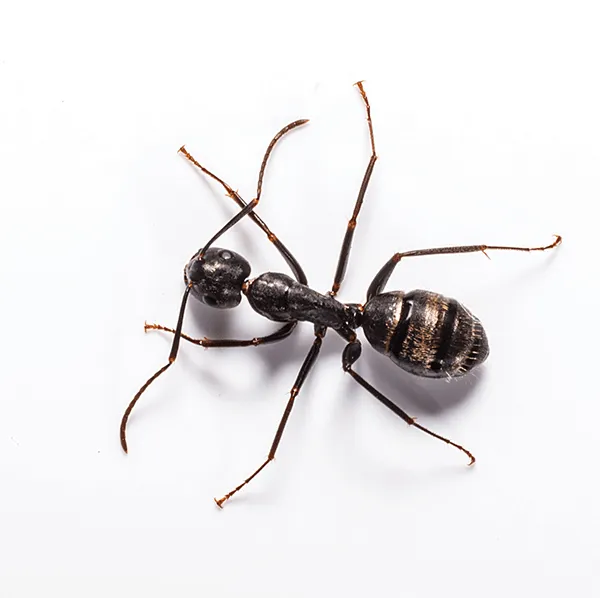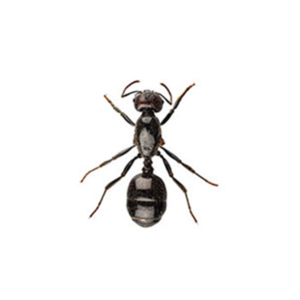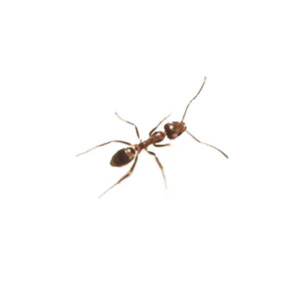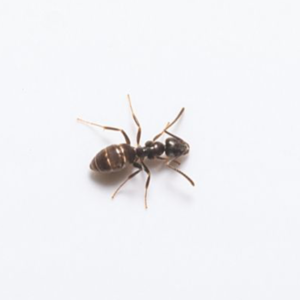Carpenter Ant Identification
Carpenter ants get their name because they excavate their nests in wood, creating smooth tunnels and galleries. Sometimes mistaken for termites, carpenter ants are wood-destroying pests that tunnel through wood to construct nests. Their nest-building activities destroy the structural integrity of homes and businesses.
What Do Carpenter Ants Look Like?
Carpenter ants are one of the larger ant species, with sizes varying from 0.3 to 1 inch. They are typically black but can also be red or brown. Key identifying features include their evenly rounded thorax and a single node, or ‘bump’, between their thorax and abdomen. Unlike termites, carpenter ants have a distinct waist and elbowed antennae.
Signs of a Carpenter Ant Infestation
Signs of a carpenter ant infestation include sightings of large, winged ants emerging from structures, piles of wood shavings (frass) beneath wooden items, and faint rustling noises inside walls or woodwork.
Habitat, Diet, Life Cycle & Bites
Where Do Carpenter Ants Live?
Drawn to moisture, carpenter ants can establish nests in a number of different locations. These locations can be either inside or outside of a home or structure and generally near damp, decaying wood. In homes and buildings, the parent nest is generally located outside in a tree, stump, or stack of firewood. Nests are more likely to be found in wood dampened by water leaks, such as attic rafters, roof overhangs, wall voids, hollow doors or columns, and in crawl spaces and behind dishwashers. Indoor carpenter ant infestations are always associated with moisture issues in homes or businesses.
Diet of Carpenter Ants
Feeding on a wide variety of foods, carpenter ants prefer the sugary honeydew excreted by plant-sucking insects.They are known to forage far from their nests in search of food. Carpenter ants do not eat and digest wood, but instead, bore through the wood and hollow it out for nesting. Over time, they seriously damage wood, reducing solid structures to hollow shells.
Life Cycle of Carpenter Ants
The life cycle of carpenter ants includes four stages: egg, larva, pupa, and adult. The queen lays eggs, which hatch into larvae. Workers then tend to the larvae, which eventually pupate and emerge as adults. The entire process can take several weeks to months, depending on environmental conditions.
Carpenter Ant Bites
Carpenter ants can bite in self-defense. Their bites can be painful due to their large mandibles, and they may inject formic acid, causing a burning sensation.
Are Carpenter Ants Dangerous?
Carpenter ants are not dangerous to humans but. Carpenter ants can pose a serious threat to homeowners. Even though carpenter ants rarely bite and are not generally thought of as dangerous, their burrowing activity can weaken and destroy the structural integrity of homes and businesses. Carpenter ant swarms usually occur in the spring and are a sure sign that a colony is nesting nearby. Seeing tiny piles of sawdust, or hearing faint rustling noises in walls are both indications of a carpenter ant infestation. While carpenter ants are not as dangerous as termites, if left unchecked, they systematically destroy homes and valuable wood objects within them. If a carpenter ant infestation is suspected, it is best to contact a professional ant exterminator.
How to Get Rid of Carpenter Ants?
Getting rid of carpenter ants typically involves identifying and destroying their nests, reducing moisture levels in your home, and creating a barrier against their entry. This can be challenging, as nests are often hidden within structures.In most cases, professional pest control services are needed to effectively eliminate the infestation – contact your local Bug Out experts to arrange a property inspection.
Carpenter Ant Prevention Tips
To prevent carpenter ant infestations, eliminate sources of moisture in and around your home. Repair leaks, replace damp or damaged wood, and ensure proper ventilation in basements, attics, and crawl spaces. Regularly inspect your home for signs of carpenter ants and maintain a barrier of cleared space around the foundation.
Need help with Carpenter Ants control?
FAQs
Should I Be Worried if I Find a Carpenter Ant?
Finding a carpenter ant in your home can be a sign of an infestation. It’s important to investigate further, as their presence could indicate structural damage due to nest building.
What Causes Carpenter Ants in a House?
Carpenter ants are often attracted to houses with moisture issues. Leaks, damp wood, and humid environments create ideal conditions for them to establish nests.





